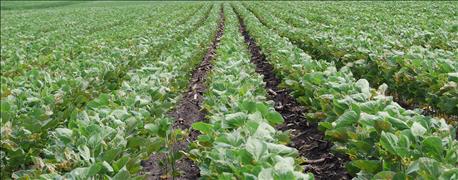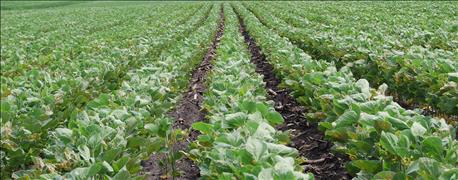June 20, 2016

Soil testing is a useful and commonly used diagnostic tool for making phosphorus (P) and potassium (K) fertilization decisions for crops. Tissue testing has been suggested for decades as another tool for testing for these and other nutrients. However, tissue testing has not been widely used for P or K in Iowa or the north-central region because of inconclusive results from limited field calibration research based on crop yield response. Iowa State University has no P or K tissue test interpretations for any crop. Thus, research was conducted by ISU the past few years to evaluate the value of tissue testing for P and K in soybeans.
ISU professor Antonio Mallarino, an ISU Extension specialist in soil fertility and nutrient management, heads this research team. He provides the following report on their results.

ISU will use results to develop the first tissue-test guidelines
Several P or K fertilizer application rates were applied to 66 response trials in 2013 and 2014, and these data were combined with data from 20 K trials that had been conducted from 2003 until 2006. Therefore, the study included 86 site-years, 34 for P and at 52 for K distributed across Iowa, and encompassed 17 soil series. Some sites were managed with no-till and others with chisel-plow/disk tillage.
The tissue tests evaluated were the P and K concentrations in aboveground soybean plants at the V5 to V6 growth stage and upper fully mature trifoliate leaves (including the petioles) at the R2 to R3 stage. Relative grain yield response was calculated for each site-year by expressing the yield for each treatment as a percentage of the statistically maximum observed yield.
Critical nutrient concentrations in soil or plant tissue distinguish between conditions of nutrient deficiency, with likely crop response to fertilization from conditions with adequate or higher levels and unlikely response. A critical concentration range was determined for each nutrient and tissue sampled by using two response models (linear-plateau and quadratic-plateau) that are commonly used for this purpose.
ISU tests show the soybean yield responses to fertilization
Initial soil-test P and K across the sites ranged from very low to very high according to ISU interpretations. ISU interpretations of soil testing results and fertilizer recommendations based on the test results are outlined in ISU publication PM 1688 “A General Guide for Crop Nutrient and Limestone Recommendations in Iowa. Average grain yield across treatments and trials ranged from 22 to 73 bushels per acre. There were statistically significant yield increases in 22 of the 34 P site-years (up to 18 bushels per acre) and in 22 of the 52 K site-years (up to 24 bushels per acre). No soybean yield response to P and K fertilization was expected in several sites because soil-test P or K was in the high or very high interpretation categories.
Using and interpreting tissue tests for phosphorusThe research results (crops.extension.iastate.edu/cropnews/2016/06/value-soybean-tissue-testing-phosphorus-and-potassium) show that the yield response to P decreased (so the relative yield increased) with increasing tissue P concentrations. The critical concentration range for young plants was 0.33% to 0.41% P. For leaves, the linear-plateau model estimated critical concentration value of 0.35% P, and the quadratic-plateau model estimated a value higher than the highest observed P concentration (0.42% P). Therefore, the critical concentration range for leaves was 0.35% to 0.42% P. The models R2 values indicate the proportion of variation explained, and were slightly higher for the small plants than for the leaves later in the season. The R2 values for both sampled tissues and response models were low (0.33 to 0.41), however, and lower than those reported for P corn tissue testing in a previous article.
The poor relationships for both soybean tissues, but mainly for the leaves, is explained by a poor capacity of tissue testing to predict the magnitude of yield response within and below the critical concentration range.
Using and interpreting tissue tests for potassium
The research (crops.extension.iastate.edu/cropnews/2016/06/value-soybean-tissue-testing-phosphorus-and-potassium) shows that the soybean yield response to K also increased with increasing tissue K concentrations. The critical concentration ranges were 1.89% to 2.26% K for young plants and 1.56% to 1.99% K for leaves later in the season. The R2 values of the relationships between tissue test K values and yield response were approximately similar for the response models fit for each tissue, but in contrast to results for P, the relationship was stronger for leaves than for young plants and also stronger than for P (0.51). The unexplained variation in the relationships was greater for young plants than for leaves later in the season, and is explained by a poorer prediction of the magnitude of response within and below the critical concentration range. Therefore, a K test for leaves at the R2-R3 growth stage was better than for young plants.
Conclusions from using tissue tests for P and K for soybeans
The study demonstrated that tissue tests can be used as in-season tools to assess the P and K sufficiency in soybeans, says Mallarino. The estimated critical concentration ranges for P and K are lower or in the lower portion of sufficiency levels suggested in the literature, which were developed mostly from older research or for other regions.
“These results will be used to develop the first soybean tissue-test P and K guidelines in Iowa, but the results showed that the value of tissue testing is not better than soil testing as a diagnostic tool,” he adds. “Also, tissue testing is of doubtful value to correct deficiencies for the sampled crop.”
Therefore, “tissue testing in soybeans should be used to complement and not substitute widespread use of soil testing for making fertilization decisions,” Mallarino says. “Its use may aid in diagnostic situations where both soil and plants can be sampled and tested for comparison of good and poor growth areas in a field to help confirm potential deficiencies.”
Acknowledgement: Funding for this study was provided by Iowa Soybean Association.
About the Author(s)
You May Also Like




